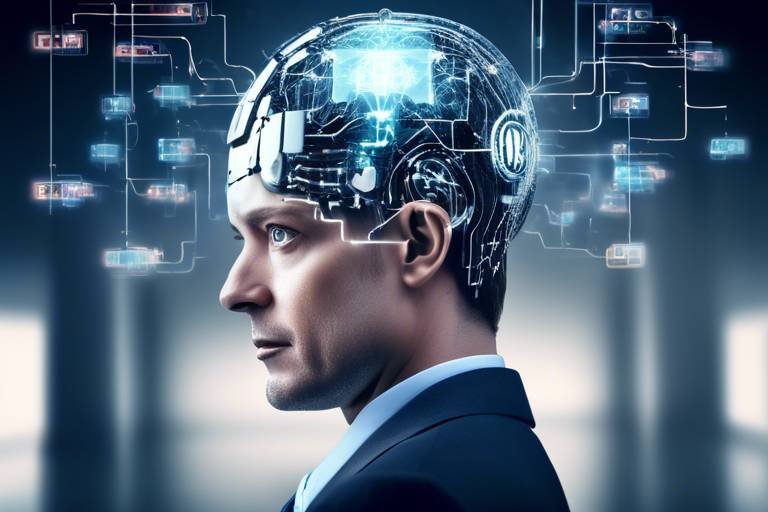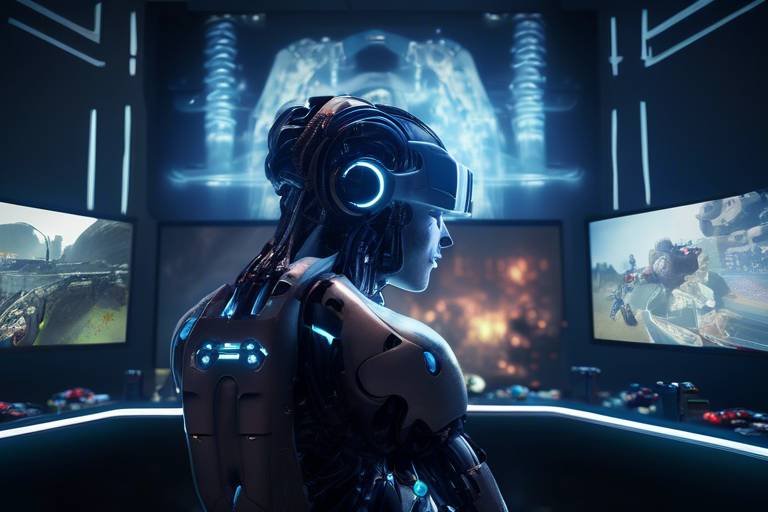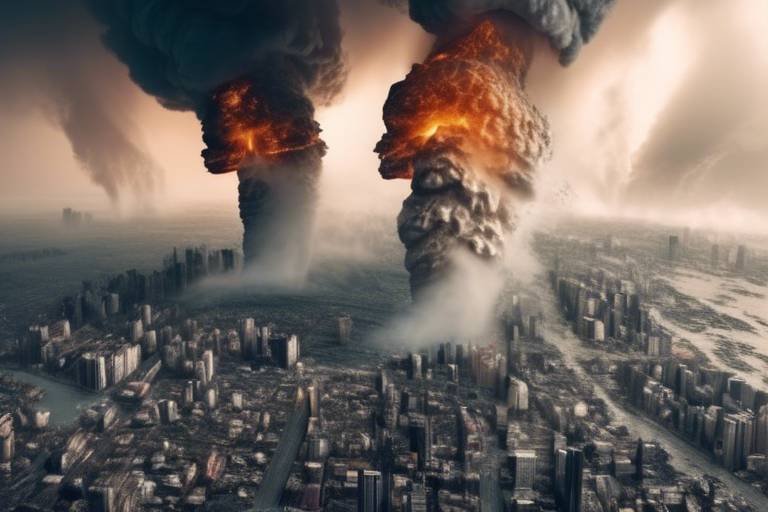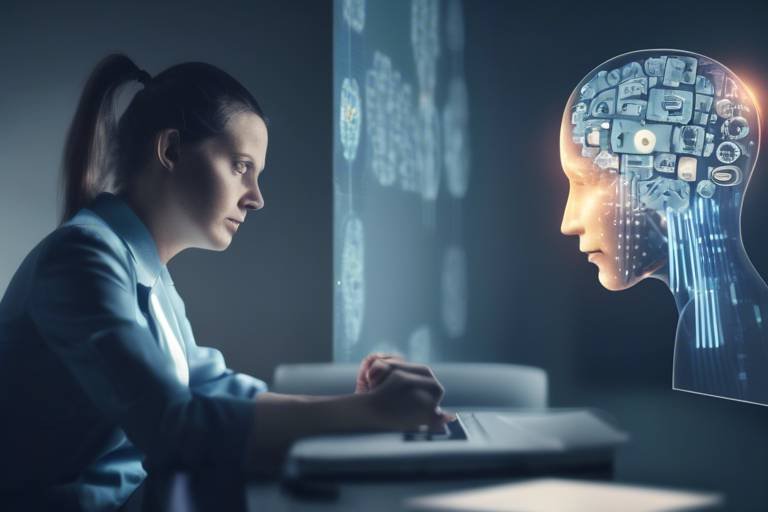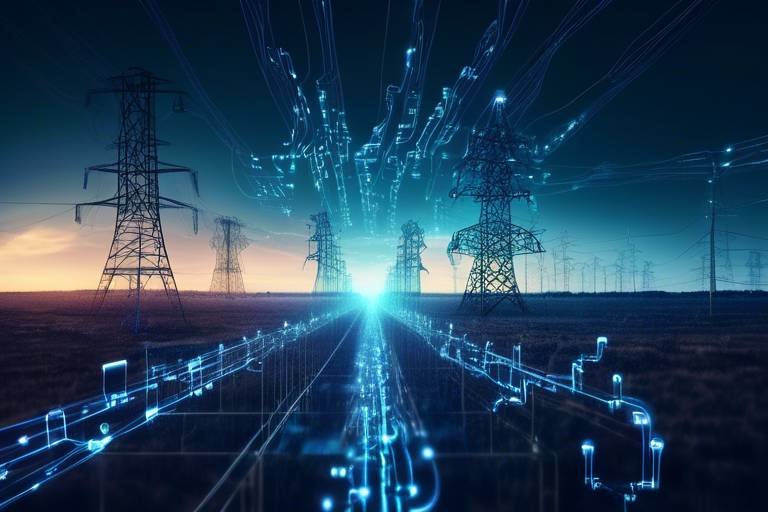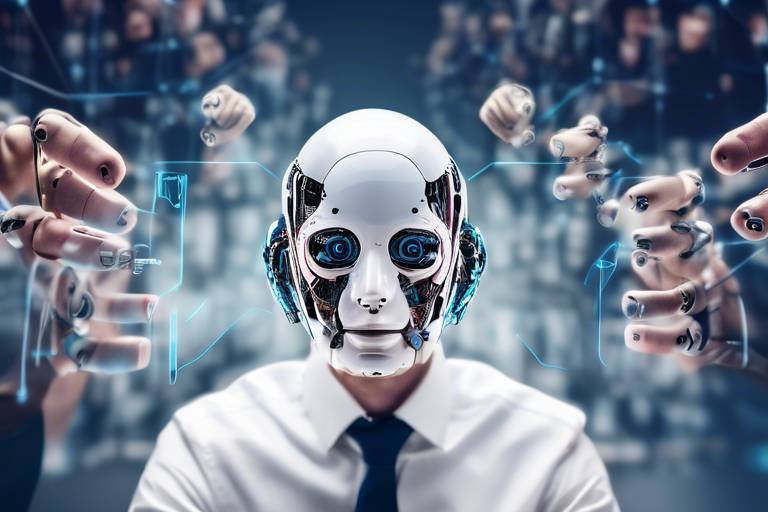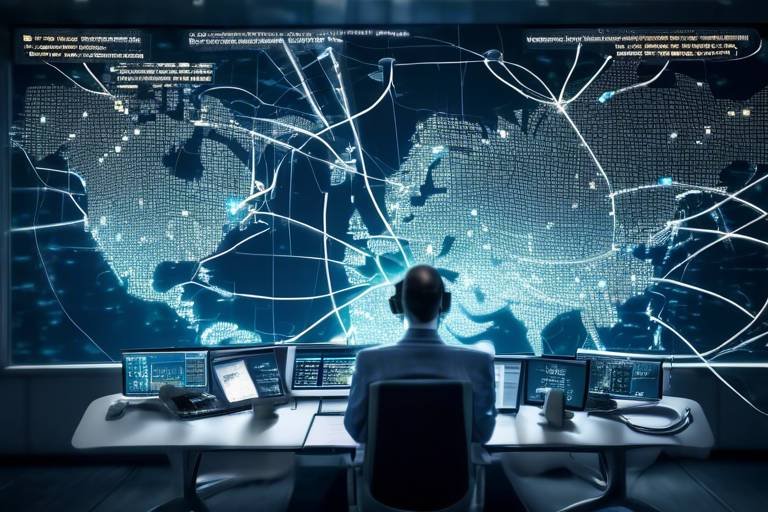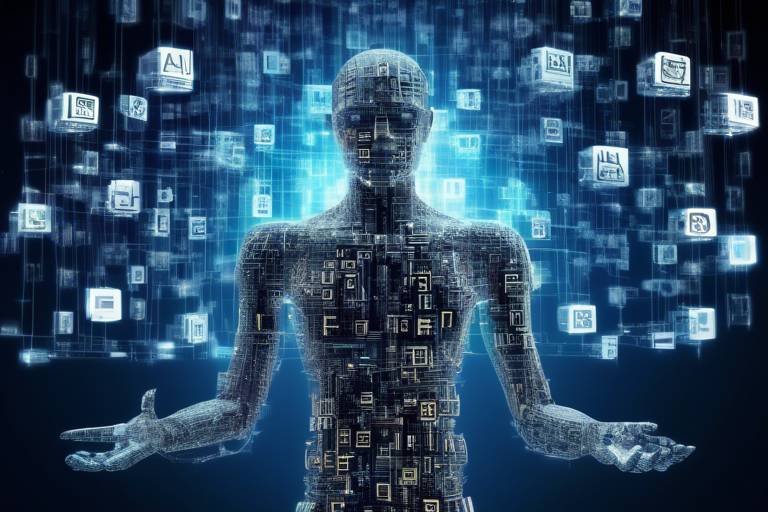The Role of AI in Astrophysics: Exploring the Cosmos
Artificial Intelligence (AI) is not just a buzzword; it’s a transformative force that is reshaping the landscape of astrophysics. Imagine standing under a starry sky, gazing at the vastness of the universe, and realizing that we are on the brink of uncovering secrets that have eluded humanity for centuries. With AI at our side, we are now equipped to decode the cosmic language of the universe, revealing insights that were previously hidden in the noise of colossal datasets. From analyzing light from distant galaxies to predicting cosmic events, AI is revolutionizing how we explore the cosmos.
In the realm of astrophysics, data is king. The sheer volume of information generated by telescopes and satellites is staggering—so much so that traditional data analysis methods simply can't keep up. Here’s where AI shines. By employing sophisticated algorithms, researchers can sift through terabytes of astronomical data, uncovering patterns and making connections that would take humans years to achieve. This capability not only accelerates research but also enhances our understanding of the universe, allowing scientists to focus on what truly matters: the mysteries of space.
As we dive deeper into this fascinating subject, it’s essential to recognize that AI doesn't just assist researchers; it empowers them. Think of AI as a cosmic detective, tirelessly working behind the scenes to analyze data, optimize telescope operations, and even simulate cosmic events. With each discovery, we are not just learning about the universe; we are redefining our place within it. The journey into the cosmos is fraught with challenges, but with AI, we are more equipped than ever to face them head-on.
In the following sections, we will explore the various ways AI is being utilized in astrophysics, from enhancing data analysis to simulating the formation of galaxies. We will also look at the future prospects of AI in this field, envisioning a time when our understanding of the universe could be transformed by these advanced technologies. Buckle up, because the journey through the cosmos is just beginning!
- What is the primary role of AI in astrophysics? AI primarily assists in data analysis, optimizing telescope operations, and simulating cosmic events, helping scientists uncover insights about the universe.
- How does AI improve the accuracy of astronomical observations? AI algorithms enhance image processing and automate the detection of celestial objects, leading to more accurate and efficient observations.
- Can AI help us understand dark matter and dark energy? Yes, AI is used to analyze complex datasets that help researchers unravel the mysteries of dark matter and dark energy.
- What future developments can we expect in AI and astrophysics? As technology evolves, we can anticipate even more sophisticated AI applications that will lead to groundbreaking discoveries about the universe.

AI-Powered Data Analysis
In the vast expanse of the universe, the amount of data generated by telescopes and space missions is nothing short of astronomical—pun intended! Traditional methods of data analysis often struggle to keep pace with the sheer volume and complexity of this information. However, artificial intelligence (AI) is stepping in as a game-changer, revolutionizing how researchers process and interpret astronomical data. By employing advanced algorithms, AI enables scientists to sift through massive datasets, uncovering patterns and insights that were previously hidden from view.
Imagine trying to find a needle in a haystack. Now, imagine that haystack is the size of a galaxy! That's where AI shines. With its ability to learn from data, AI can identify trends and anomalies at lightning speed. For instance, researchers can utilize AI to analyze light curves from variable stars or to detect distant exoplanets through their transit signatures. This capability not only accelerates the research process but also enhances the accuracy of findings, leading to more reliable conclusions.
One of the most remarkable aspects of AI-powered data analysis is its ability to automate routine tasks. This allows astronomers to focus on what they do best: interpreting results and making groundbreaking discoveries. Here are a few ways AI is transforming data analysis in astrophysics:
- Pattern Recognition: AI algorithms can identify complex patterns in data that might elude human researchers, such as subtle variations in light from distant stars.
- Data Categorization: By classifying astronomical objects into categories—like stars, galaxies, and quasars—AI helps streamline the analysis process.
- Anomaly Detection: AI can flag unusual events, such as supernovae or gamma-ray bursts, that warrant further investigation.
Furthermore, AI's ability to process data in real-time is nothing short of revolutionary. This means that astronomers can receive immediate feedback on their observations, allowing for quicker decision-making and more efficient use of telescope time. For example, during a survey of the night sky, AI can continuously analyze incoming data, alerting researchers to transient events as they occur. This real-time monitoring is crucial for understanding the dynamic nature of the cosmos.
In summary, AI-powered data analysis is not just a technological advancement; it's a paradigm shift in how we explore and understand the universe. As we continue to harness the power of AI, we can expect to uncover even more secrets of the cosmos, pushing the boundaries of human knowledge further than ever before. The future of astrophysics is bright, and AI is at the forefront of this exciting journey.

Machine Learning in Telescope Operations
Machine learning is not just a buzzword in the tech world; it's a game-changer in the field of astrophysics, particularly when it comes to telescope operations. Imagine standing in front of a massive telescope, peering into the depths of the universe, and having an intelligent system that can help you make sense of the countless stars, galaxies, and cosmic phenomena you observe. This is the reality today, thanks to the integration of machine learning technologies into telescopic operations.
One of the most significant advancements has been in the area of image processing. Traditional methods of analyzing images captured by telescopes can be time-consuming and often yield less-than-perfect results. However, machine learning algorithms can quickly sift through vast amounts of data, identifying patterns and anomalies that the human eye might miss. This capability not only speeds up the analysis process but also enhances the accuracy of the findings, allowing astronomers to focus on what truly matters—unraveling the mysteries of the universe.
Moreover, machine learning optimizes telescope operations by automating the detection of celestial objects. Imagine a scenario where a telescope is scanning the night sky, and within seconds, it can identify and classify various astronomical objects, such as stars, planets, and even exoplanets. This level of automation drastically reduces the time researchers spend on manual data analysis, enabling them to allocate their efforts toward more profound scientific inquiries.
The ability of AI systems to identify and classify astronomical objects in real-time is a remarkable feat. By employing advanced machine learning techniques, telescopes can now autonomously detect celestial bodies and phenomena, significantly streamlining the research process. For instance, when a telescope captures an image, the integrated AI can analyze it in seconds, categorizing objects based on predefined parameters. This leads to a more efficient workflow, allowing astronomers to focus on interpreting the data rather than getting bogged down in the analysis.
One of the most exciting applications of machine learning in telescope operations is the rapid detection of transient astronomical events. Events like supernovae and gamma-ray bursts occur suddenly and can provide critical insights into the life cycles of stars and the nature of the universe. With AI at the helm, telescopes can monitor the sky continuously, alerting researchers to these fleeting events almost instantaneously. This capability not only enhances our understanding of such phenomena but also opens up new avenues for research that were previously unattainable.
Advanced AI techniques are also pivotal in improving the quality of astronomical images. By employing algorithms that reduce noise and artifacts, machine learning enhances the clarity and detail of the images captured by telescopes. This improvement means that researchers can analyze celestial phenomena with greater precision, leading to more accurate conclusions and discoveries. The clearer the images, the better the understanding of the universe's complex tapestry.
In conclusion, the integration of machine learning in telescope operations is revolutionizing the way astronomers conduct their research. With automated object detection, real-time monitoring of transient events, and enhanced image quality, machine learning is not just a tool; it's a partner in the quest to explore the cosmos. As we continue to push the boundaries of technology, the role of AI in astrophysics will only become more pronounced, paving the way for groundbreaking discoveries that will reshape our understanding of the universe.
- What is machine learning? Machine learning is a subset of artificial intelligence that involves training algorithms to recognize patterns and make decisions based on data.
- How does machine learning improve telescope operations? It automates data analysis, enhances image quality, and enables real-time detection of celestial objects and events.
- Can machine learning help in discovering new celestial objects? Yes, by quickly analyzing vast amounts of data, machine learning can identify previously unknown objects in the universe.
- What types of astronomical events can AI detect? AI can detect a variety of transient events such as supernovae and gamma-ray bursts, providing valuable data for research.

Automated Object Detection
In the vast, dark expanse of the universe, where countless celestial bodies dance around each other, the ability to identify and classify these objects quickly and accurately is nothing short of revolutionary. Enter , a game-changing application of artificial intelligence that is reshaping the landscape of astrophysics. Imagine having a super-smart assistant that can sift through mountains of data at lightning speed, pinpointing everything from distant galaxies to fleeting comets. That’s precisely what AI is doing in the realm of astronomy.
Traditionally, astronomers would spend countless hours manually analyzing images captured by telescopes, searching for specific features or anomalies. This painstaking process often left them with only a fraction of the data analyzed, resulting in missed discoveries. However, with the advent of AI, particularly through machine learning algorithms, this labor-intensive task has been transformed. These algorithms are designed to learn from vast datasets, allowing them to recognize patterns and classify objects in real-time.
So how does this work? At its core, automated object detection involves training AI systems on extensive datasets of astronomical images. The AI learns to identify various celestial objects based on their unique characteristics, such as brightness, shape, and color. Once trained, the AI can then process new images, rapidly identifying and categorizing objects with remarkable accuracy. This not only saves time but also enhances the overall efficiency of observational campaigns. For instance:
- Speed: AI can analyze data in real-time, allowing astronomers to react quickly to transient events.
- Accuracy: With advanced algorithms, the likelihood of human error is significantly reduced.
- Volume: AI can handle and process data from multiple telescopes simultaneously, expanding the scope of research.
One of the most exciting applications of automated object detection is in the monitoring of transient astronomical events. These events, such as supernovae, gamma-ray bursts, and asteroid flybys, can occur suddenly and without warning. The ability to detect these occurrences in real-time is crucial for understanding their nature and origins. Thanks to AI, researchers can now capture and analyze these phenomena almost instantaneously, leading to groundbreaking insights and discoveries.
Moreover, the improvement in image quality facilitated by AI plays a significant role in automated object detection. Advanced algorithms can reduce noise and artifacts in images, resulting in clearer visualizations of celestial phenomena. This enhanced clarity allows for more accurate identification and classification of objects, further driving the field of astrophysics forward.
In summary, automated object detection powered by AI is not just a technological advancement; it’s a paradigm shift in how we explore and understand the universe. By automating the identification and classification of celestial objects, we can unlock new discoveries at an unprecedented pace, pushing the boundaries of our knowledge about the cosmos. As we continue to develop and refine these technologies, the future of astrophysics looks incredibly bright.
Q: What is automated object detection in astrophysics?
A: Automated object detection refers to the use of artificial intelligence algorithms to identify and classify celestial objects in astronomical images, enhancing data analysis efficiency.
Q: How does AI improve the detection of transient events?
A: AI enables real-time monitoring and rapid detection of transient events like supernovae and gamma-ray bursts, allowing researchers to gather critical insights quickly.
Q: What are the benefits of using AI for image processing in astronomy?
A: AI improves image quality by reducing noise and artifacts, leading to clearer and more informative visualizations of celestial phenomena, which aids in accurate classification.

Real-Time Monitoring of Transients
In the vast expanse of the universe, transient astronomical events such as supernovae, gamma-ray bursts, and gravitational waves occur fleetingly, often lasting only a few moments to days. The real-time monitoring of these transients has become a game changer in astrophysics, thanks to the remarkable capabilities of artificial intelligence. Imagine trying to catch a glimpse of a shooting star; now, think about capturing not just a fleeting moment, but the entire story behind it. This is precisely what AI enables astronomers to do!
AI systems are designed to process vast amounts of data from telescopes and other observational instruments almost instantaneously. By employing sophisticated algorithms, these systems can detect anomalies in real-time, alerting researchers to events that demand immediate attention. For instance, when a supernova occurs, it can be detected within moments of its explosion, allowing scientists to study its characteristics and gather invaluable data that could lead to breakthroughs in our understanding of stellar evolution.
Moreover, the automation of this process significantly reduces the time researchers spend sifting through data. Traditionally, astronomers would manually analyze images and data, a task that could take days or even weeks. Now, with AI, the detection of transient events can happen in a matter of seconds. This rapid response is crucial, as many of these events provide insights into the fundamental processes that govern the universe. For example, the swift identification of a gamma-ray burst can lead to follow-up observations with other telescopes, maximizing the scientific yield from these rare occurrences.
To illustrate the impact of AI on real-time monitoring, consider the following table that highlights some key transient events and the AI technologies used to detect them:
| Event Type | AI Technology Used | Significance |
|---|---|---|
| Supernovae | Neural Networks | Understanding stellar life cycles |
| Gamma-Ray Bursts | Machine Learning Algorithms | Investigating extreme cosmic phenomena |
| Gravitational Waves | Deep Learning | Probing the fabric of spacetime |
As we look to the future, the potential of AI in real-time monitoring will only expand. With advancements in technology, we can expect even faster and more accurate detection methods, leading to a deeper understanding of the universe. The synergy between human ingenuity and artificial intelligence is paving the way for unprecedented discoveries, making the cosmos more accessible than ever before. In a way, it's like having a superpower that allows scientists to see what was once invisible, turning the ephemeral into the eternal.

Enhancing Image Quality
When we gaze up at the night sky, the beauty and complexity of the cosmos can leave us in awe. However, capturing that beauty through telescopes often presents challenges, primarily due to noise and various artifacts that can obscure celestial details. This is where artificial intelligence steps in, revolutionizing the way we enhance astronomical images. By employing advanced AI techniques, researchers can significantly improve the quality of images obtained from telescopes, leading to clearer and more informative visualizations of celestial phenomena.
Imagine trying to view a stunning painting in a dimly lit room; the details are lost in shadows and imperfections. Similarly, astronomical images can suffer from poor visibility due to atmospheric distortions and electronic noise. AI acts like a skilled curator, adjusting the lighting, enhancing colors, and refining the details, allowing us to appreciate the intricate features of galaxies, nebulae, and other celestial bodies.
One of the most effective methods used in this enhancement process is deep learning, a subset of machine learning. Deep learning algorithms, particularly convolutional neural networks (CNNs), are trained on vast datasets of high-quality astronomical images. They learn to identify and reduce noise while preserving essential details, resulting in images that are not only clearer but also more scientifically valuable. For instance, a CNN might analyze thousands of images of the same celestial object, learning to distinguish between genuine features and noise. This capability is crucial for researchers who rely on accurate data for their studies.
Moreover, AI can automate the image enhancement process, making it faster and more efficient. Researchers can now process large volumes of data in a fraction of the time it would take using traditional methods. This efficiency is vital, especially when dealing with transient events like supernovae or gamma-ray bursts, where timely data analysis can lead to significant discoveries. The ability to quickly produce high-quality images allows scientists to respond rapidly to these fleeting phenomena, capturing moments that would otherwise be lost.
In addition to improving image clarity, AI also facilitates the integration of multi-wavelength data. Astronomers often gather data from various wavelengths, such as optical, infrared, and radio. AI algorithms can combine these datasets to produce comprehensive images that provide a more complete picture of celestial objects. This multi-faceted approach enables researchers to analyze phenomena from different perspectives, leading to deeper insights into their nature and behavior.
In summary, the role of AI in enhancing image quality in astrophysics cannot be overstated. By leveraging advanced algorithms, researchers can transform raw data into stunning visualizations that reveal the universe's secrets. As we continue to explore the cosmos, the synergy between artificial intelligence and astronomical imaging will undoubtedly lead to groundbreaking discoveries and a richer understanding of the universe.
- What is the role of AI in astrophysics? AI is used to process large datasets, enhance image quality, and automate the detection of celestial objects.
- How does AI improve astronomical images? AI algorithms reduce noise and artifacts, leading to clearer and more detailed visualizations.
- What are the benefits of using deep learning in image processing? Deep learning allows for the automation of image enhancement and the ability to analyze vast amounts of data quickly.
- Can AI help in discovering new celestial phenomena? Yes, AI enables faster data analysis, allowing researchers to detect and study transient events more effectively.

Predictive Modeling in Astrophysics
In the vast and complex realm of astrophysics, predictive modeling serves as a powerful tool that allows scientists to simulate and understand cosmic events and phenomena. Imagine being able to create a virtual universe where you can test hypotheses and visualize the intricate dance of celestial bodies! This is precisely what AI enables researchers to do. By leveraging advanced algorithms and vast datasets, AI can model the dynamics of galaxies, star formation processes, and even the enigmatic interactions of black holes.
One of the most exciting aspects of predictive modeling in astrophysics is its ability to simulate scenarios that would be impossible to recreate in reality. For instance, scientists can explore the formation of galaxies over billions of years, observing how they evolve and interact with one another. This not only helps in understanding the present state of the universe but also sheds light on its historical development and potential future.
AI-driven models can analyze and predict various phenomena, such as:
- Galaxy Collisions: By simulating the gravitational interactions between galaxies, researchers can predict how these massive structures will collide and merge over time.
- Star Formation Rates: Predictive models help scientists estimate how quickly stars are born in different environments, contributing to our understanding of stellar evolution.
- Black Hole Dynamics: AI can simulate the behavior of matter around black holes, providing insights into their formation and growth.
Moreover, predictive modeling is not just about understanding the past or present; it also plays a crucial role in forecasting future cosmic events. For example, researchers can use AI models to predict the likelihood of supernova explosions or the potential for gamma-ray bursts, which can have significant implications for our understanding of the universe's lifecycle.
As we continue to refine these predictive models, the potential for groundbreaking discoveries increases exponentially. The fusion of AI with astrophysical research is akin to having a sophisticated telescope that not only observes but also interprets and predicts cosmic phenomena. This innovative approach is paving the way for a deeper understanding of the universe and its many mysteries.
Q: What is predictive modeling in astrophysics?
A: Predictive modeling in astrophysics involves using algorithms and simulations to forecast cosmic events and understand the dynamics of celestial bodies, such as galaxies, stars, and black holes.
Q: How does AI enhance predictive modeling?
A: AI enhances predictive modeling by processing massive datasets quickly and efficiently, allowing researchers to simulate complex scenarios that would be difficult or impossible to replicate in real life.
Q: Can predictive modeling help in understanding dark matter and dark energy?
A: Yes, predictive modeling can provide insights into dark matter and dark energy by simulating their effects on cosmic structures and dynamics, helping researchers unravel their mysteries.
Q: What are some applications of predictive modeling in astrophysics?
A: Applications include simulating galaxy collisions, predicting star formation rates, and understanding black hole dynamics, among others.

AI in Cosmological Simulations
Artificial Intelligence (AI) is not just a buzzword in today's tech-driven world; it is a transformative force that is reshaping the field of astrophysics, particularly in the realm of cosmological simulations. Imagine trying to understand the vastness of the universe with its billions of galaxies, each containing millions of stars, all while sifting through terabytes of data. Sounds overwhelming, right? This is where AI steps in, acting as a powerful ally to researchers, helping them make sense of the cosmic chaos.
Cosmological simulations are complex models that aim to replicate the formation and evolution of cosmic structures. Traditionally, these simulations required immense computational power and time, often taking weeks or even months to yield results. However, with the advent of AI, scientists can now accelerate these processes significantly. By leveraging machine learning algorithms, researchers can analyze and interpret data at unprecedented speeds. This not only saves time but also allows for more iterations and refinements in their models.
One of the most exciting aspects of AI in cosmological simulations is its ability to enhance the accuracy of models. For instance, AI algorithms can identify patterns and correlations within massive datasets that human analysts might overlook. This capability is crucial in understanding complex phenomena such as:
- Galaxy Formation: AI helps simulate how galaxies form and evolve over billions of years, providing insights into their lifecycle.
- Dark Matter and Energy: By analyzing complex datasets, AI aids in unraveling the mysteries of dark matter and dark energy, which play vital roles in the universe's structure and expansion.
- Cosmic Events: AI can predict and model rare cosmic events, enhancing our understanding of their impact on the universe.
Moreover, the integration of AI into these simulations allows for real-time adjustments based on new data. This dynamic approach means that as researchers gather more information from telescopes and other observational instruments, they can immediately update their simulations to reflect the latest findings. This adaptability is crucial in a field where new discoveries are made almost daily.
To illustrate the impact of AI on cosmological simulations, consider the following table that summarizes key benefits:
| Benefit | Description |
|---|---|
| Speed | AI accelerates data processing, reducing the time needed for simulations. |
| Accuracy | Improved algorithms enhance the precision of models, leading to better predictions. |
| Adaptability | Real-time updates allow simulations to incorporate the latest observational data. |
| Pattern Recognition | AI identifies hidden patterns in complex datasets that may be missed by humans. |
As we look to the future, the role of AI in cosmological simulations is poised to expand even further. With advancements in technology and computational power, we can expect AI to unlock new frontiers in our understanding of the universe. Imagine being able to simulate entire galaxies in real-time or predict cosmic events before they happen! The possibilities are endless, and the excitement in the scientific community is palpable.
In conclusion, AI is not merely a tool but a revolutionary force that is enhancing our ability to explore and understand the cosmos. As we continue to push the boundaries of technology and science, the collaboration between AI and astrophysics will undoubtedly lead to groundbreaking discoveries that will reshape our understanding of the universe.
- How does AI improve cosmological simulations?
AI enhances the speed and accuracy of simulations, allowing researchers to make real-time adjustments based on new data. - What are some specific applications of AI in astrophysics?
AI is used for galaxy formation studies, dark matter analysis, and predicting cosmic events. - Will AI replace human researchers in astrophysics?
No, AI is a tool that complements human expertise, enabling scientists to focus on interpretation and discovery.

Understanding Dark Matter and Energy
When we gaze up at the night sky, it's easy to feel a sense of wonder and mystery. But did you know that a staggering 95% of the universe is made up of things we can't see? That's right! This enigmatic composition consists of dark matter and dark energy, two of the most intriguing concepts in modern astrophysics. Despite their elusive nature, AI is stepping in to help scientists peel back the layers of this cosmic mystery.
Dark matter, which makes up about 27% of the universe, is thought to be responsible for the gravitational effects we observe in galaxies and galaxy clusters. Although we can't see dark matter directly, its presence is inferred from the way galaxies rotate and how they interact with one another. Imagine trying to solve a puzzle without being able to see all the pieces—this is the challenge astrophysicists face when studying dark matter.
On the other hand, dark energy is an even more perplexing phenomenon. Comprising about 68% of the universe, dark energy is believed to be driving the accelerated expansion of the cosmos. It's like a mysterious force pushing galaxies apart at an ever-increasing rate, and we still have so many questions about what it really is. How can something so powerful remain so elusive? This is where artificial intelligence comes into play.
AI algorithms are designed to sift through vast amounts of astronomical data, helping researchers identify patterns and correlations that would be nearly impossible to detect manually. For instance, by analyzing the cosmic microwave background radiation and other datasets, AI can help determine the distribution of dark matter and the effects of dark energy on the universe's expansion. It's like having a super-smart detective on your team, piecing together clues that lead to groundbreaking discoveries.
Moreover, AI's ability to model complex systems enhances our understanding of how dark matter and dark energy influence the structure of the universe. Researchers can simulate various cosmological scenarios, adjusting parameters related to dark matter and energy, to see how these changes affect the formation and evolution of galaxies. This process not only aids in visualizing cosmic structures but also allows scientists to test their hypotheses more rigorously.
To illustrate the impact of AI in this field, consider the following table that highlights how AI contributes to our understanding of dark matter and energy:
| AI Contribution | Description |
|---|---|
| Data Analysis | AI processes complex astronomical datasets to reveal hidden patterns related to dark matter. |
| Simulation | AI models the effects of dark energy on cosmic expansion, helping scientists visualize its impact. |
| Predictive Modeling | AI predicts the behavior of dark matter in various cosmic scenarios, aiding in hypothesis testing. |
As we continue to harness the power of AI, our understanding of dark matter and dark energy will undoubtedly deepen. The journey to uncover the secrets of the universe is just beginning, and with each new discovery, we're not just learning about the cosmos—we're also learning about ourselves and our place within this vast, mysterious expanse.
- What is dark matter? Dark matter is a form of matter that does not emit light or energy, making it invisible and detectable only through its gravitational effects.
- What is dark energy? Dark energy is a mysterious force that is thought to be responsible for the accelerated expansion of the universe.
- How does AI help in studying dark matter and dark energy? AI analyzes large datasets and simulates cosmic scenarios to uncover patterns and insights related to dark matter and dark energy.
- Why is dark matter important? Understanding dark matter is crucial for explaining the formation and behavior of galaxies and the overall structure of the universe.

Galaxy Formation and Evolution
When we gaze up at the night sky, we see a tapestry of stars and galaxies, each telling its own story of formation and evolution. The process of galaxy formation is akin to watching a masterful artist at work, with cosmic materials swirling together over billions of years to create breathtaking structures. With the help of artificial intelligence (AI), researchers are now able to simulate these complex processes, revealing insights that were once thought to be mere speculation.
AI algorithms allow scientists to model the intricate dynamics involved in galaxy formation. By analyzing vast datasets generated from telescopes and simulations, these algorithms can identify patterns and predict how galaxies evolve over time. Imagine a time-lapse video of a flower blooming—AI gives us a similar perspective on galaxies, showing us the stages of their development. From the initial clumping of gas and dust to the eventual formation of stars and planets, AI helps us understand the timeline of galactic evolution.
One of the most exciting applications of AI in this field is its ability to simulate different conditions under which galaxies can form. For instance, researchers can input various parameters such as the density of dark matter, the rate of star formation, and the influence of neighboring galaxies. By manipulating these factors, AI can generate multiple scenarios, each depicting a different evolutionary path. This is crucial for understanding why some galaxies are spiral-shaped while others are elliptical, and how external forces can alter their trajectories.
To illustrate this, consider the following table that summarizes different types of galaxies and their characteristics:
| Galaxy Type | Characteristics |
|---|---|
| Spiral Galaxies | Flat, rotating disks with arms that spiral outward; often contain a significant amount of gas and dust. |
| Elliptical Galaxies | Rounded shapes with little gas and dust; primarily composed of older stars. |
| Irregular Galaxies | Chaotic shapes without a defined structure; often rich in gas and dust. |
Moreover, AI's role extends beyond just simulating formation; it also aids in understanding the interactions between galaxies. These interactions can lead to phenomena such as galaxy mergers, which can drastically change the structure and composition of both galaxies involved. Think of it as two rivers converging—each brings its own flow and sediment, creating a new landscape. AI helps model these interactions, allowing scientists to predict outcomes such as starbursts, where intense star formation occurs due to gravitational forces.
In summary, the integration of AI into the study of galaxy formation and evolution is not just a technological advancement; it's a paradigm shift. By leveraging AI's computational power, researchers can uncover the secrets of the cosmos, enhancing our understanding of how galaxies form, evolve, and interact. As we continue to explore the universe, AI will undoubtedly play a pivotal role in unraveling the mysteries of our galactic neighbors.
- What is the role of AI in galaxy formation research? AI helps simulate and analyze the processes of galaxy formation, allowing scientists to predict how galaxies evolve over time.
- How does AI improve our understanding of dark matter? AI algorithms can analyze complex datasets to uncover patterns related to dark matter's influence on galaxy formation and evolution.
- Can AI predict future galactic events? Yes, AI can model different scenarios based on various parameters, helping scientists predict future interactions and evolutions of galaxies.

Future Prospects of AI in Astrophysics
The future of artificial intelligence (AI) in astrophysics is not just bright; it’s positively *stellar*! As we stand on the brink of a technological revolution, the potential for AI to transform our understanding of the universe is immense. Imagine a world where AI not only assists scientists but also drives the discovery of new celestial phenomena and enhances our grasp of cosmic mysteries. With each passing day, advancements in AI algorithms and computational power are opening doors to unprecedented research methodologies.
One of the most exciting prospects is the development of more sophisticated machine learning models that can analyze astronomical data at lightning speed. These models will be able to sift through the *gigantic* datasets generated by telescopes and space missions, identifying patterns and anomalies that human researchers might overlook. For instance, as we gather more data from missions like the James Webb Space Telescope, AI will play a crucial role in managing and interpreting this information, leading to groundbreaking discoveries.
Furthermore, the integration of AI in astrophysics is paving the way for enhanced collaborative research across global scientific communities. Imagine a network of AI systems working in tandem, sharing insights and findings in real-time. This could lead to a more unified approach to tackling some of the universe's most pressing questions, such as the nature of dark matter and the mechanics of black holes. The possibilities are endless, and the collaboration between AI and astrophysics is set to redefine our cosmic explorations.
As we look towards the future, we can expect AI to contribute significantly to predictive modeling in astrophysics. By simulating cosmic events and phenomena, AI will allow scientists to visualize and understand the dynamics of the universe in ways we have never imagined. For example, researchers could use AI to predict the outcomes of galaxy collisions or the behavior of supermassive black holes, providing insights that could reshape our understanding of cosmic evolution.
Moreover, AI is likely to play a pivotal role in the search for extraterrestrial life. With its ability to analyze vast amounts of data from exoplanet surveys, AI can help identify potentially habitable planets and analyze their atmospheres for signs of life. This could be a game-changer in the quest to answer one of humanity's oldest questions: Are we alone in the universe?
In summary, the future prospects of AI in astrophysics are not just about enhancing our current capabilities; they are about *revolutionizing* the way we explore and understand the cosmos. As we continue to innovate and integrate AI technologies, we stand on the threshold of a new era in astrophysics, one that promises to unveil the secrets of the universe like never before.
- What role does AI play in astrophysics? AI helps process vast amounts of astronomical data, enhances telescope operations, and aids in predictive modeling of cosmic events.
- How can AI help in the search for extraterrestrial life? AI analyzes data from exoplanet surveys to identify potentially habitable planets and detect signs of life in their atmospheres.
- What are some potential future applications of AI in astrophysics? Future applications include improved data analysis, enhanced simulations of cosmic phenomena, and collaborative research across global scientific communities.
Frequently Asked Questions
- How is AI being used in astrophysics?
AI is transforming astrophysics by analyzing massive datasets, optimizing telescope operations, and enhancing image quality. It helps researchers uncover patterns and insights that were previously out of reach, making it a game-changer in understanding the universe.
- What role does machine learning play in telescope operations?
Machine learning improves telescope operations by automating image processing and detecting celestial objects in real-time. This boosts observational efficiency and accuracy, allowing astronomers to focus on more complex analyses.
- Can AI detect transient astronomical events?
Absolutely! AI systems can rapidly identify transient events like supernovae and gamma-ray bursts, providing researchers with crucial information about these phenomena's nature and origins almost instantly.
- How does AI improve the quality of astronomical images?
Advanced AI techniques reduce noise and artifacts in astronomical images, resulting in clearer visualizations of celestial phenomena. This clarity helps scientists make more informed conclusions about their observations.
- What is predictive modeling in astrophysics?
Predictive modeling uses AI to simulate cosmic events, providing insights into complex dynamics such as galaxy formation and black hole interactions. It allows scientists to explore scenarios that would be impossible to recreate physically.
- How does AI assist in understanding dark matter and dark energy?
AI algorithms analyze intricate datasets to help decipher the mysteries of dark matter and dark energy, which make up a significant part of the universe's mass-energy content. This understanding is crucial for advancing our knowledge of the cosmos.
- What are the future prospects of AI in astrophysics?
The future of AI in astrophysics looks incredibly promising. As technology continues to advance, we can expect even greater integration of AI, leading to groundbreaking discoveries and a deeper understanding of the universe.







